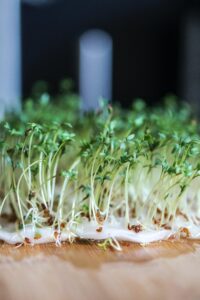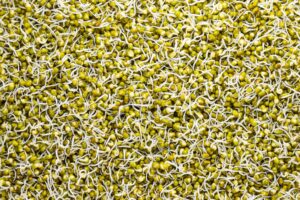SPROUTING: BENEFITS AND HOW TO DO IT
Seeds offer amazing nutritional value and are a great addition to our diet. They contain fibre, vitamins, minerals, protein and healthy fats, on top of valuable phytonutrients. When seeds are sprouted, they become living plants that can be stored in the fridge to retain all their goodness. Anything that can help to increase my intake of nutrients is greatly appreciated, that’s why I like to add them to salads, sandwiches, smoothies and/or any dish that require a garnish.
Because of the harsh conditions found in nature, many nuts, grains and seeds also contain enzyme inhibitors that protect them from damage during their initial stage of growth. The problem is that when ingested, the enzyme inhibitors also slow down the absorption of nutrients that we ingest with food. By sprouting we can break down these enzyme inhibitors and let them release their full nutritional potential.
We can sprout a variety of seeds from vegetables, grains, nuts and beans.
HOW TO SPROUT?
Sprouts are amazingly easy to grow at home, they are ready in about 2 to 7 days, and they do not need any soil. You can grow them all year around on your windowsill and the seeds are ridiculously cheap to buy. If you are willing to invest some money you can buy a sprouter, there are few different types online and in health food stores. Otherwise keep things cheap and cheerful by repurposing an old glass jar and a fine cheesecloth, that’s really all you need. When the sprouts are ready, ensure that are kept in the fridge for a maximum of 1 week.
WHICH ONE TO USE?
Here I share what I use the most and why, however it is fun to experiment with different ones and see which ones are your favourites. Generally, sprouts have high levels of antioxidants that help to lower inflammation and fight free radicals. Speak to your healthcare practitioner if you take any medication, as some sprouts contain high vitamin K levels that interact with clotting.
 BROCCOLI SPROUTS
BROCCOLI SPROUTS
Soak them overnight, rinse and drain. Place them in a glass jar and rinse the seeds 3 times a day, until they are ready in about 6 to 9 days (at this point you will see an open double leaf). Broccoli sprouts are rich in sulforaphane, a natural compound that has been researched for its beneficial effects on Nrf2, a molecule that is involved in over 500 genes, including the ones in phase 1 and 2 detoxification. This means that eating broccoli sprouts can help us eliminate toxins more efficiently, which is particularly important if we live in polluted areas. Another great benefit is the excellent number of antioxidants contained, which slows down aging by fighting free radicals. Sulforaphane can also decrease overall inflammation, helping with inflammatory conditions like psoriasis and eczema. Finally, it seems to defend brain cells and improve mental impairments, although we need more research to confirm it.
ALFALFA
There is no need to soak them, just rinse, drain and place them in a glass jar. Thereafter water the seeds twice daily, until they are ready in about 5 to 7 days. It is better to keep them at cooler temperatures (but not too cold), because when left in hotter places, they might develop mould. The skin of the seed has a small amount of arsenic, so ensure you wash them off as best as you can to remove any potential harmful compounds. Alfalfa is high in vitamin K, essential for blood clotting, and has been used in ayurvedic medicine to decrease the oxidative damage from free radicals due to the antioxidant content. Few small studies have also confirmed the cholesterol lowering properties of Alfalfa, possibly due to the phytochemical saponin. It is important to note that Alfalfa contain phytoestrogen, which attach to oestrogen receptors in the body. Avoid it if you are pregnant or breastfeeding.
 MUNG BEANS
MUNG BEANS
Must be soaked for at least 8 hours. Rinse, drain and place them in a sprouting jar. They need to be rinsed twice a day until they are ready in about 2 to 3 days (when the length of the shoot is as long as the bean itself). Mung bean is a green legume that have been used in ayurvedic diets for centuries because has an excellent protein profile for a plant-based source. They too seem to have cholesterol lowering properties thanks to their antioxidant content. Because of their very high in folate content (also known as folic acid or B9), mung bean sprouts can help the correct formation of DNA and RNA in our cells and prevent neural tube defects during pregnancy. Folate also decreases homocysteine levels in the body, therefore decreasing the risk of heart disease, while the phytochemicals vitexin and isovitexin, seem to help against cell injury during heat stroke due to their antioxidant activity.
There are many more options to choose from, like lentils, sunflower seeds and wheatgrass, however I mentioned the ones that I find myself using more often because of their benefits and my dietary requirements. Remember to eat your sprouts as fresh as possible to reap all the benefits.
REFERENCES:
Cao, D. Li, H. Yi, J. et al. (2011). Antioxidant properties of the mung bean flavonoids on alleviating heat stress. PLoS One. 2011;6(6):e21071. doi: 10.1371/journal.pone.0021071. Epub 2011 Jun 10. PMID: 21695166; PMCID: PMC3112222.
Chon, S.U. (2013). Total polyphenols and bioactivity of seeds and sprouts in several legumes. Curr Pharm Des. 2013;19(34):6112-24. doi: 10.2174/1381612811319340005. PMID: 23448441.
Fahey, J.W. & Kensler, T.W. (2021). The Challenges of Designing and Implementing Clinical Trials with Broccoli Sprouts… and Turning Evidence into Public Health Action. Frontiers in nutrition, 8, 648788. https://doi.org/10.3389/fnut.2021.648788
Li, H. Cao, D. Yi, J. Cao, J. et al. (2017). Identification of the flavonoids in mungbean (Phaseolus radiatus L.) soup and their antioxidant activities. Food Chem. 2012 Dec 15;135(4):2942-6. doi: 10.1016/j.foodchem.2012.07.048. Epub 2012 Jul 17. PMID: 22980894.
Li, H. Li, J. Shen, Y. et al. (2017). Legume Consumption and All-Cause and Cardiovascular Disease Mortality. BioMed research international, 2017, 8450618. https://doi.org/10.1155/2017/8450618
Malinow, M.R. McLaughlin, P. & Stafford, C. (1980). Alfalfa seeds: Effects on cholesterol metabolism. Experientia 36, 562–564 (1980). https://doi.org/10.1007/BF01965801
Mandrich, L., & Caputo, E. (2020). Brassicaceae-Derived Anticancer Agents: Towards a Green Approach to Beat Cancer. Nutrients, 12(3), 868. https://doi.org/10.3390/nu12030868
Mölgaard, J. von Schenck, H. Olsson, A.G. (1987). Alfalfa seeds lower low-density lipoprotein cholesterol and apolipoprotein B concentrations in patients with type II hyperlipoproteinemia. Atherosclerosis. 1987 May;65(1-2):173-9. doi: 10.1016/0021-9150(87)90019-0. PMID: 3606731.
Sadeghi, L. Tanwir, F. Yousefi Babadi, V. (2016). Antioxidant effects of alfalfa can improve iron oxide nanoparticle damage: In vivo and invitro studies. Regul Toxicol Pharmacol. 2016 Nov; 81:39-46. doi: 10.1016/j.yrtph.2016.07.010. Epub 2016 Jul 18. PMID: 27445214.
Sun, Y. Yang, T. Mao, L. & Zhang, F. (2017). Sulforaphane Protects against Brain Diseases: Roles of Cytoprotective Enzymes. Austin journal of cerebrovascular disease & stroke, 4(1), 1054. https://doi.org/10.26420/austinjcerebrovascdisstroke.2017.1054








